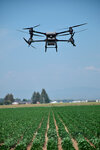Cloudy, 57° F
Around Wyoming farmers and other residents may begin noticing a low buzzing craft spraying fields instead of the typical high flying crop dusters that most are accustomed to.
Since June, …
This item is available in full to subscribers.
The Powell Tribune has expanded its online content. To continue reading, you will need to either log in to your subscriber account, or purchase a subscription.
If you are a current print subscriber, you can set up a free web account by clicking here.
If you already have a web account, but need to reset it, you can do so by clicking here.
If you would like to purchase a subscription click here.
Please log in to continue |
|




Around Wyoming farmers and other residents may begin noticing a low buzzing craft spraying fields instead of the typical high flying crop dusters that most are accustomed to.
Since June, Western Wings Drone Service of Dayton has begun servicing fields in Wyoming. Their third outing was completed in Powell on local farmer Jared Snell’s land — the job was carried out through a contract with Simplot. Drone pilot Jake Masters said all the spraying he does in the Big Horn Basin is through the Simplot contract.
Nick Paulsen, an applicator for Simplot, said that the company had been wanting to start using drones after they had been successful on crops, such as onions and potatoes, in Idaho. The drone use falls under Simplot Smart Farm which focuses on agricultural technology.
While the drone has been working more in the southern areas of the Basin like Worland, Emblem and Burlington, Paulsen said that fields have been sprayed for Powell growers including Delfino Juarez and Rick Rodriguez.
“Our crop advisers have talked to the crop providers and they want to try it out,” Paulsen said.
Masters flies the drone for his parents Doug and Stephanie, who own Western Wings Drone Service.
“This is kind of our trial year … to see how effective [it is] and how everything’s going to work,” Masters said.
He did not have an exact number of fields he has serviced but said that the number is growing every day.
The drone, which they fly under a contract with Rantizo, (an agtech company focused on sustainability and drone technology) has a tank in the center and flies thanks to four propellers. Western Wings’ drone is capable of spraying 3 gallons an acre every 3.1 minutes or 5 gallons an acre every 4.2 minutes, Masters said.
Other benefits include better accuracy when it comes to starts and stops and the ability to get into tighter spots, Masters said. The downforce generated by the propellers also helps the spray better cover the crop.
Paulsen added that the drone has allowed growers’ fields to be sprayed despite the rainy weather which can prevent traditional methods.